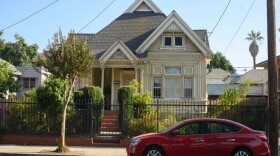Bliss is 4 1/2 acres in eastern San Diego County for Gerda Govine Ituarte, 77, and her husband Carlos Luis Ituarte, 75.
Last year, the retired couple bought a Spanish-style hacienda surrounded by lush greenery in the rural enclave of Jamul.
“This is our dreamland,” Gerda said. “It’s as though this place was waiting for us all our lives.”
But fate didn’t finance the couple’s bucolic paradise. California’s gilded real estate market did. The couple bought their new home for $610,000 after selling their Pasadena townhouse last fall for $500,000.
The Ituartes, like many baby boomers, came of age when California was still a middle-class haven. Wages kept up with the cost of living and homes were still affordable. Through their homeownership and other income, the Ituartes’ middle-class lifestyle continues into retirement.
“California real estate is like gold,” Luis said. “We were able to take advantage of this amazing evolution where a house that was bought for north of $90,000 is now worth over half a million dollars. That allowed us to buy this place. It’s like going from one heaven to another heaven.”
This story is part of a series from the California Dream project called Graying California. Seniors are the fastest growing age group in the state.
We profile some of California's 6 million seniors to better understand how their experiences point the way ahead and shape the California dream.
Gerda purchased the townhome for $99,000 in 1985 as a single mom who worked as an educator. Back then, many Californians, including baby boomers, seized the chance to buy houses.
A typical home in California cost around three times the average young family’s income in the late 1960s, based on figures from the Public Policy Institute of California and the California Association of Realtors. Today, that home costs seven times what an average young family makes.
That phenomenon is reflected in homeownership numbers.
Around 60% of California seniors own their homes, according to the California Budget & Policy Center’s analysis of U.S. Census, American Community Survey data for 2017.
“Most of those seniors have paid them off,” said Steven P. Wallace, associate director of the UCLA Center for Health Policy Research and the principal investigator with the Elder Index, a tool used by policymakers to figure out how much income California seniors require to meet basic needs.
And that’s why whether it’s for living expenses or living in Shangri-la, homeownership is helping subsidize retirement for California’s elderly. While that’s also true for the rest of the United States, owning property in California yields a bigger windfall.
“There’s a uniqueness here because other places around the country just do not have the kind of home equity gains that people have experienced in California,” said Erik Bruvold, an economist and chief executive officer of the San Diego North Economic Development Council. “And for a certain segment of California seniors, home equity is an important part of their retirement nest egg.”
RELATED: A Senior On The Streets, With Little Chance Of A Home
Home equity aside, the state’s seniors had careers at a time when the cost of living was reasonable enough to allow them to sock away money for retirement. Company pensions were also more common. About 39.3% of California seniors have retirement income in addition to Social Security, according to the California Budget & Policy Center.
“The idea was that retirement would be a three-legged stool,” Bruvold said. “It would be pensions, savings and Social Security.”
Luis gets a pension from his job in the cultural affairs department at the city of Los Angeles. Gerda is a retired educator and diversity consultant. In addition to Luis’s pension, the couple live off of retirement savings and their combined Social Security income.

“It’s our survival,” Gerda said.
But what about today’s middle-class families? Can they do what Gerda and Luis did — buy a home and sell it three decades later to finance an idyllic retirement?
“It’s not attainable at all in most parts of the state, in the urban areas at least, for middle-class families if you haven’t bought that home already,” said Kevin Prindiville, executive director of the nonprofit Justice in Aging, a legal advocacy group aimed at ending senior poverty. “Housing prices have skyrocketed so much that it’s a smaller and smaller proportion of the population that can afford homes at these prices.”
Today’s families also can’t depend on pensions.
“It’s just not likely that they’re going to retire with a comfortable, economically secure retirement,” Prindiville said. “They will have Social Security. But a lot of people haven’t been able to establish another source of retirement savings.”
Just 22% of Californians had defined benefit pension plans last year, according to the Bureau of Labor Statistics.
The Ituartes realize they’re fortunate that they can count on multiple sources of income in their retirement.
“We have surely benefitted from the fact that we’re older and came of age at a certain time,” Gerda said.
Gerda is a poet. She has published four books of her poetry and is working on a fifth. Luis is a sculptor and painter.
The couple plan to use their newly purchased property in eastern San Diego County to inspire other artists. Luis wants to hold art camps in the summer.
“This could be an open space gallery, a place where people can come and see artists working and see displays of artwork in nature,” Luis said.
Gerda envisions weekend retreats for women.
“I’m talking seasoned women,” Gerda said. “Women 60-plus, who are writers or poets, but they’re shying away from it. I want them to come out and experience the freedom, the air to tap what’s already there.”
As they looked out on their sprawling property on a recent overcast day, the couple was joyful about their future.
“We’re gonna take a chance,” Gerda said. “We’re gonna go into this wide open space and see what happens.”






